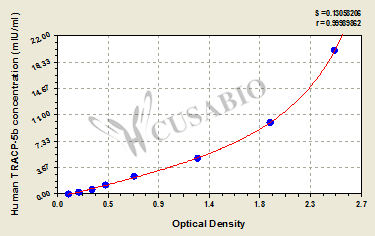The human TRACP5b ELISA kit (CSB-E08490h) is designed for the quantitative measurement of human TRACP5b protein in serum, plasma, or tissue homogenates. It quantitates human TRACP5b with 0.078 mIU/ml sensitivity and shows excellent specificity for human TRACP5b. It uses the bi-antibody sandwich enzyme immunoassay technique. This assay employs a biotin-conjugated TRACP5b antibody that recognizes the analyte bound by the immobilized TRACP5b antibody, forming an antibody-analyte-antibody complex. The immune complex is further detected by avidin-conjugated HRP. The TMB solution is added into the wells and turns blue and finally turns yellow after the addition of the stop solution. Solution color develops in proportion to the amount of TRACP5b in the sample. The O.D. value is measured using a microplate reader at 450 nm and is used to determine the concentration of the human TRACP5b in the sample.
TRACP5b (ACP5), secreted by osteoclasts, is increased in osteoporosis individuals and is used as a specific and sensitive marker of bone resorption and bone remodeling. After release into circulation, TRACP5b becomes inactive and is degraded into fragments that are removed by the liver. TRACP5b has been applied to diagnose bone diseases such as osteoporosis and bone metastasis and for monitoring antiresorptive treatment. Alatalo et al and Rissanen et al have shown that TRACP5b is a good indicator of osteoclast number in mouse bone marrow-derived osteoclasts and human blood monocyte-derived osteoclasts.




